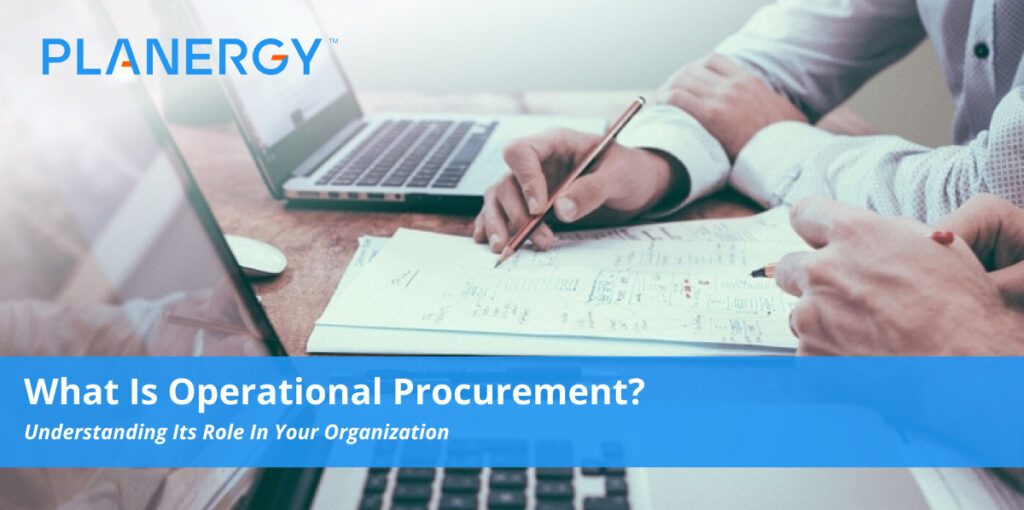In procurement, there are multiple processes and strategies to consider. Operational procurement refers to the procurement of goods and services that are required to sustain an organization’s day-to-day business operations.
You may also hear it referred to as MRO purchasing, which refers to maintenance, repair, and operations because these purchases are necessary to keep the business running.
Operational procurement is not the same as tactical purchasing, which is focused on short-term transactional activity.
The routine approach takes a reactive stance in regards to purchasing materials and supplies.
It relies on using fast quote and order processes so that production can continue to run smoothly.
It is not to be confused with strategic sourcing, which is based on a long-term approach that promotes the timely supply of necessary goods and services that are critical to the organization’s ability to meet its core objectives.
Operational procurement deals with purchasing goods and services the organization needs, contract management, delivery management, and addressing any complaints.
It’s about optimizing purchasing functions so that the company has access to the materials they need when they need them, in the correct amount, at the right place, and the best possible price.
The larger the company, the more benefit they will get from applying operational procurement principles to their overall procurement processes.
That’s not to say that smaller businesses won’t achieve any benefit from leveraging operational procurement practices, because different offices may require the same exact office supplies, and two different manufacturing facilities may require the exact same raw material for their production processes, even if they are across the globe from another.
Benefits of Operational Procurement
Applying operational procurement best practices to your procurement function provides cost savings in a number of ways.
First and foremost, there are financial benefits because larger contracts can be negotiated with suppliers for goods or services used in a different company location.
You’ll save on labor costs because the entire operational procurement workflow will run smoother and procurement processes won’t have to be started over and over again from scratch.
The history will be accessible and shared within the organization for ease of use.
You’ll also see improvement in your reporting capabilities because you’ll be able to extract data from the system, share it with the pertinent team members and stakeholders, and generate reports on a variety of key performance indicators related to the entire procurement process for internal purchasing organization.
The operational procurement process can be broken down into three pieces: plan, buy, and pay. The first stage, plan, is the planning part, while the last two steps are the operational part.
How Operational Procurement Works
Demand Determination
The operational procurement process begins with demand determination. It involves taking time to determine what the company needs, what services or materials are necessary for everyone to perform their jobs.
Once the needs are detailed, it’s time to move on to determine the sources. Who will be able to deliver the products to the locations where they are needed, and where they will be used.
The demand determination phase addresses the creation of a purchase requisition.
The person who needs the materials will fill out the requisition in Planergy and submit it for approval to the department head, or the designated approver based on the workflow that’s setup in the organization.
Supplier Selection
After the requisition for goods and services has been submitted, it’s necessary to make supplier selection based on the current purchase time, quality, and quantity.
If the procurement team doesn’t currently have a contracted vendor to meet the needs of the requisition, they can send out a Request for Quotations (RFQ) to ask suppliers to provide their terms for a specific order.
They send these to all possible providers in a timely manner to let the company know if and how they will be able to deliver the requested goods or services.
From there, suppliers that are able to fulfill the demand will provide a quote that lists their exact terms and conditions for that order delivery.
These answers become the first binding documents of the operational procurement process.
If the quote is accepted but the terms aren’t complied with, it is considered a breach of contract, which may result in legal actions.
The procurement department will compare the quotes that have been received, and they will choose the best offer.
That offer is the most affordable vendor who offers the highest quality and will be able to fulfill the order in time.
Order Monitoring
Once the supplier has been selected, it’s time to convert the purchase requisition to a purchase order so that it becomes a legally binding document.
It asks the supplier to deliver the goods or services as agreed per the conditions. The purchasing department sends the order to their contact at the vendor.
In Planergy, once the requisition is approved, it automatically becomes a purchase order if a vendor is already attached.
To create a purchase order for a requisition that didn’t have a supplier attached at first, add the vendor information and approve it.
While waiting for orders to be delivered, the orders are monitored.
This process involves checking to see if the stocks are going to be available on time, if the previous production steps can be started, and if the planned next steps will be finished on time.
Once the goods are received, they are registered to inventory and checked against the order to be sure it was fulfilled correctly.
The warehouse team handles the goods receipt process.
At this stage, you may find any number of surprises such as missing goods, poor quality, broken products, wrong sizes, etc.
Any of these issues may lead to the creation of additional documents to trigger a return or negotiate a credit with the supplier. In extreme situations, it may be necessary to pursue legal action.
Invoice Process
Once the goods have been marked received, it’s time to move to invoice processing.
Planergy uses a built-in three-way matching process to ensure the goods received match the purchase order, and the invoice from the vendor matches what was ordered and received. If there’s a problem, it is flagged for manual review.
The invoice is the final document in the procurement process, and payment should be processed as soon as possible after order receipt according to the terms of your contract with the vendor.
Late payments can damage your supplier relationship and lead to costly late fees or delayed repeat orders. Once the invoice is settled, the purchasing process is complete so that finished goods can be produced or resale can occur.




